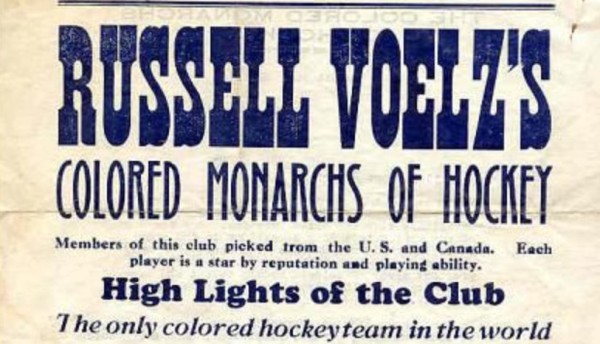
The History of the Colored Monarchs of Hockey
Among the frozen lakes of Minnesota, one of hockey’s most unlikely stories remains hidden. The Colored Monarchs are believed to be the first all-Black professional hockey team from the United States.

Among the frozen lakes of Minnesota, one of hockey’s most unlikely stories remains hidden.
If you follow the Mississippi River from the home ice of the NHL’s Minnesota Wild, you’ll pass one of the NCAA’s newest Division I men’s hockey schools, St. Thomas University, followed by one of America’s winningest NCAA hockey programs, the University of Minnesota.
Eventually, the River turns North, bypassing the town of Robbinsdale to the East. It’s here, in Robbinsdale, what is now a quiet suburb of Minneapolis, that the Colored Monarchs of Hockey came into existence in 1934. The Monarchs are believed to be the first all-Black professional hockey team in United States hockey history.
The team was the brainchild of sports promoter Russell Voelz in 1932. Voelz was born and raised in Minneapolis, lettering in high school in football and hockey.
In 1932, Voelz ventured into the sporting world. That year, he launched the Northern League, a new professional baseball circuit, where he became the league’s first president and was also the owner of a franchise, the Grand Forks Colts. That same year, Voelz concocted the idea of an all-Black hockey team.
He’d seen the barnstorming all-Black baseball teams of the era, and believed a hockey team could find equal financial success. One of those teams, who had won the Negro National League championship four times in the 1920s, the Kansas City Monarchs, is thought to be the inspiration for the hockey club’s nickname.
After ending his presidency of baseball’s Northern League after only one season, Voelz turned his full attention to hockey, namely, filling a roster of Black hockey players to become the Colored Monarchs of Hockey.
The roster was built of players primarily from Nova Scotia and Quebec, although news reports also claim players from New York, Boston, Chicago, and Pittsburgh were recruited. With the Colored Hockey League of the Maritimes ceasing operations in 1930, it’s possible players and Voelz alike saw an opportunity for Black athletes in hockey elsewhere in North America.
Voelz soon moved the players to Minnesota, and in August of 1934, issued a challenge to the world.
“Whether your club be the Chicago Black Hawks or America’s weakest club, we still guarantee to give you the greatest hockey show on earth,” Voelz’s poster, which he released to media and sent to clubs across the Western United States and Canada, read.
His advertisement claimed that the Monarchs were “the only colored professional hockey team in the world” and that they would “play any team any place on one week's notice.”
Accompanying his poster, Voelz sent a letter to sports editors evoking other barnstorming successes, including baseball’s Monarchs, and basketball’s Harlem Globetrotters, “You know doubt have heard of the great colored base-ball club the Kansas City Monarchs and the colored basketball club the Globe Trotters. Now Comes one of the most outstanding sensations in the sport world, the Colored Monarchs of hockey. We have the greatest array of colored hockey talent and many of these boys would be playing major league hockey if white.”
Voelz hoped to use a tactic of the time, barnstorming, to help gain notoriety, and make financial gains. Barnstorming involved playing challenge games facing teams in city after city, which at the time, was a major source of competition for all-Black teams in a variety of sports, where Black players were denied entry into formal leagues. While barnstorming produced huge crowds and prosperity for players and owners, it was also seen as a type of minstrel entertainment for White fans hoping to mock Black athletes.
While it is uncertain if the Colored Monarchs of Hockey ever embarked on their journey to play teams across North America, at least one notable team responded to, and accepted Voelz’s challenge.
Sending out his original request for challengers, the lone recorded response came from the Saskatoon Quakers. That season, the Quakers represented Canada at the 1934 World Hockey Championships, winning a gold medal by defeating the United States 2-1 in the final.
“We would be very much interested in making arrangements to play you a series of four games this winter,” the Quakers wrote to Voelz.
“We might mention that in 1932-33 we were Western Canada Champions and in 1933-34 World’s Amateur Champions at Milan, Italy.”
The stumbling block for the Monarchs however may have been the lack of professional hockey teams available to play exhibition games at the time, and the team’s lack of sanctioning from the Canadian Amateur Hockey Association, which would eventually merge with Hockey Canada to form Canada’s governing body of the sport.
As The Winnipeg Tribune wrote in the summer of 1934, “It has taken Voelz two years to assemble a good team, but how good they really are we cannot say at present time.”
Unfortunately, if the Monarchs ever stepped on the ice, no record has been uncovered, so the mystery of this team, and how good they really were, or could have been, will remain.